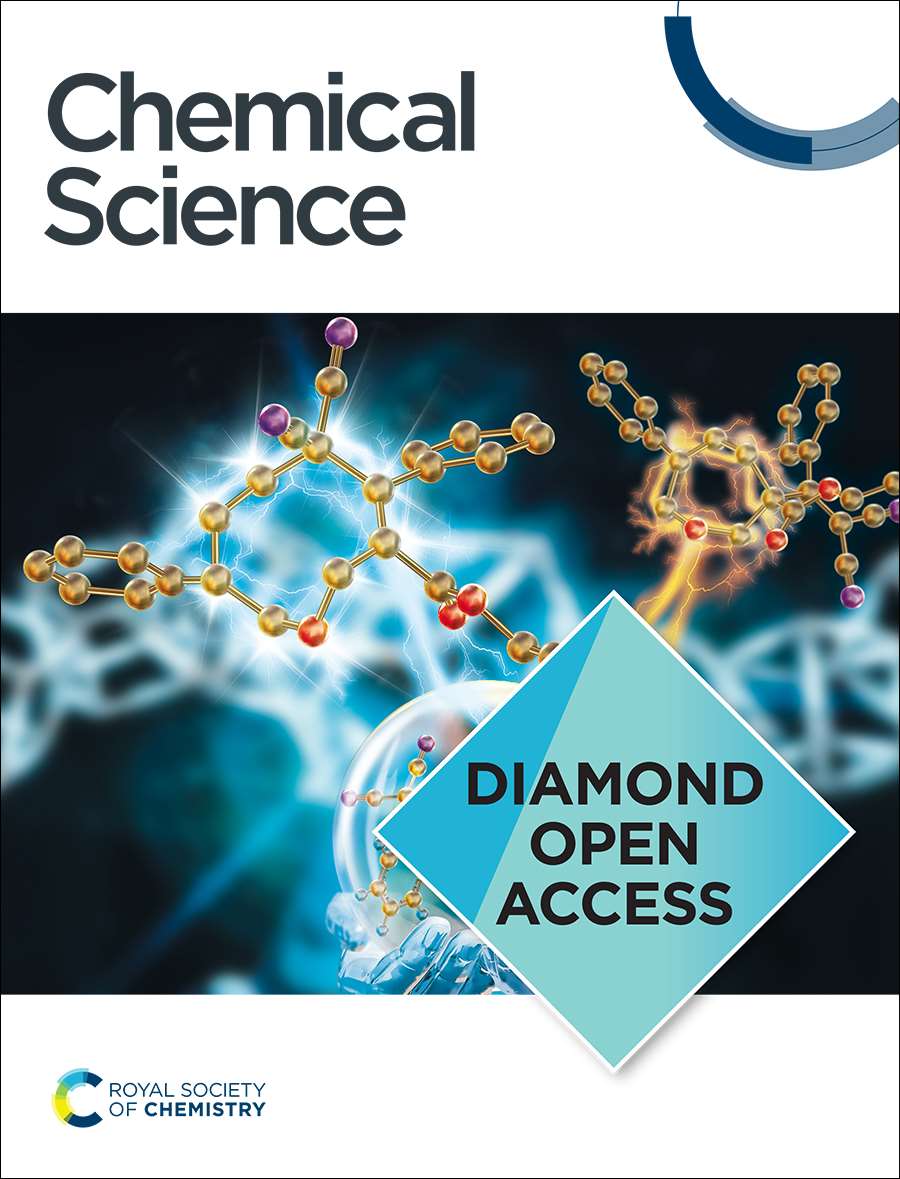Uncovering Intramolecular Singlet Fission at the Root of the Dual Fluorescence of 1,4-Bis(p-nitro-β-styryl)benzene in Solution
IF 7.6
1区 化学
Q1 CHEMISTRY, MULTIDISCIPLINARY
引用次数: 0
Abstract
The exploration of singlet fission (SF) promises a pathway to many leaps forward including more efficient solar energy extraction and, more recently, organic-based quantum computing. Our study, through a joint experimental and computational approach, revolves around 1,4-bis(p-nitro-β-styryl)benzene (1) as the smallest molecule where the intramolecular transformation of the initially allowed 11Bu singlet state to the 21Ag excited state stops being ordinary internal conversion and becomes the first half of the SF process. Herein, we experimentally observe explicit breaking of Kasha rule. Using femtosecond broadband fluorescence upconversion, we measure a dual fluorescence of 1 in solution from its two lowest singlet excited states of different symmetry. Femtosecond transient absorption (TA) and fluorescence upconversion spectroscopy of 1 in toluene reveal ultrafast (17±5 ps), almost quantitative interconversion between 11B and 21A states. A sensitization bracketing experiment with ns-TA is used to analyze the T1 state of 1. Employing high-level ab initio extended multi-configuration quasi-degenerate 2nd-order perturbation theory (XMCQDPT2) calculations, we accurately model ground- and excited-state potential energy surfaces. 11B states are predominantly described by ordinary HOMO–LUMO excitation. 21A states can be projected in localized frontier molecular orbitals as intramolecular strongly coupled triplet biexciton [1(T1T1)] with the inclusion of intramolecular charge-transfer states. Moreover, the experimental resemblance of 21A and T1 absorption is elucidated. Fluorescence temperature-dependence experiment further corroborates the XMCQDPT2 model accurate prediction of the 11B and 21A low barrier of crossing (ca. 600 cm-1). Concentration-dependent experiment shows a dramatic increase in triplet yield: up to 200% yield is confirmed by both ns-TA quantitative measurements and detailed analysis of the fs-TA data. All the obtained results suggest the occurrence of a SF mechanism for the triplet production: intramolecular 1(T1T1) formation followed by intermolecular triplet separation aided by entropy and spatial separation.揭示溶液中1,4-二(对硝基-β-苯乙烯)苯双荧光根源的分子内单线态裂变
单线态裂变(SF)的探索有望带来许多飞跃,包括更高效的太阳能提取,以及最近基于有机的量子计算。我们的研究采用实验与计算相结合的方法,以1,4-双(对硝基-β-苯乙烯)苯(1)为最小分子,在分子内由最初允许的11Bu单重态转变为21Ag激发态,不再是普通的内部转化,成为SF过程的前半部分。在这里,我们通过实验观察到卡沙规则的显式破坏。利用飞秒宽带荧光上转换,我们测量了溶液中两个不同对称的最低单重态激发态的双荧光。1在甲苯中的飞秒瞬态吸收(TA)和荧光上转换光谱显示11B和21A态之间的超快(17±5 ps)、几乎定量的相互转换。采用ns-TA敏化包套实验对1的T1状态进行分析。采用高阶从头算扩展多组态准简并二阶微扰理论(XMCQDPT2)计算,我们精确地模拟了基态和激发态势能面。11B态主要由普通的HOMO-LUMO激发描述。21A态可以在分子边界轨道上投射为分子内强耦合三重态双激子[1(T1T1)],并包含分子内电荷转移态。此外,还阐明了21A和T1吸收的实验相似性。荧光温度依赖性实验进一步证实了XMCQDPT2模型对11B和21A低过交势垒(约600 cm-1)的准确预测。浓度依赖性实验表明,三重态产率显著提高:ns-TA定量测量和fs-TA数据的详细分析证实,产率可达200%。所有的结果都表明了三重态产生的SF机制:分子内1(T1T1)形成,然后在熵和空间分离的帮助下进行分子间三重态分离。
本文章由计算机程序翻译,如有差异,请以英文原文为准。
求助全文
约1分钟内获得全文
求助全文
来源期刊

Chemical Science
CHEMISTRY, MULTIDISCIPLINARY-
CiteScore
14.40
自引率
4.80%
发文量
1352
审稿时长
2.1 months
期刊介绍:
Chemical Science is a journal that encompasses various disciplines within the chemical sciences. Its scope includes publishing ground-breaking research with significant implications for its respective field, as well as appealing to a wider audience in related areas. To be considered for publication, articles must showcase innovative and original advances in their field of study and be presented in a manner that is understandable to scientists from diverse backgrounds. However, the journal generally does not publish highly specialized research.
 求助内容:
求助内容: 应助结果提醒方式:
应助结果提醒方式:


